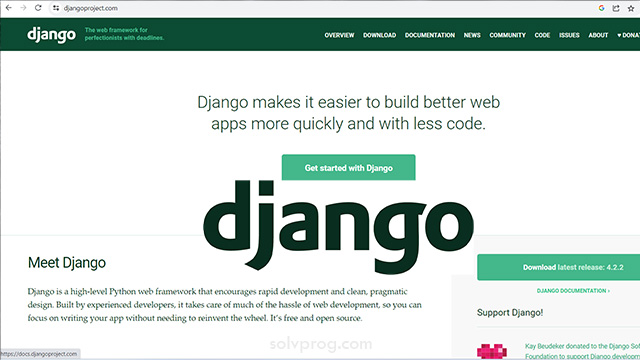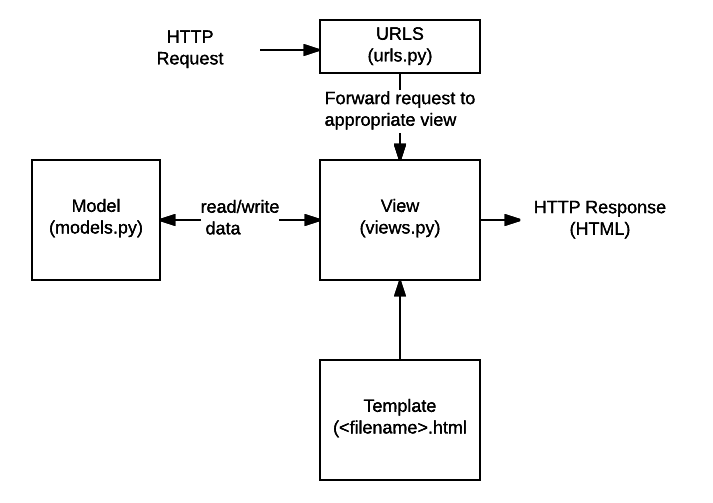What is Django Web Framework?

Django is a powerful web framework that simplifies the process of building web applications. Whether you're a beginner or an experienced developer, Django provides an intuitive and efficient way to bring your web ideas to life. In this blog, we'll explore the key concepts and features of Django, and how it makes web development a breeze.
What is Django?
Django is a high-level web framework written in Python that enables developers to build robust and scalable web applications quickly and efficiently. It follows the model-view-controller (MVC) architectural pattern, also known as the model-view-template (MVT) pattern, which helps in organizing code and separating concerns.
Django provides a set of pre-built tools and libraries that simplify common web development tasks, allowing developers to focus on building application logic rather than dealing with low-level details. It offers features like URL routing, form handling, database ORM (Object-Relational Mapping), template engine, user authentication, session management, and more.
The framework follows the "batteries included" philosophy, meaning it includes many out-of-the-box features and functionalities, reducing the need for developers to reinvent the wheel. Django promotes code reusability, modularity, and follows best practices, making it a popular choice for web development.
With Django, developers can create database-backed web applications efficiently, handle complex URL routing, render dynamic web pages using templates, and interact with databases seamlessly. It also provides an administration interface, known as the Django Admin, which automates many administrative tasks and allows easy management of application data.
Django is known for its scalability, security, and community support. It has a vibrant ecosystem with a wide range of third-party packages and extensions available, making it versatile and adaptable to various project requirements.
Overall, Django simplifies web development by providing a well-structured framework, powerful features, and excellent documentation, making it an excellent choice for building web applications of any size and complexity.
This framework's tagline is well-known: "The web framework for perfectionists with deadlines."
We can create web apps in a very short period of time by utilizing Django. Django is structured in such a way that it handles much of the configuration automatically, allowing us to focus solely on application development.
What is Django framework used for?
Django is a flexible web framework for creating online applications. It includes a suite of tools and functions that allow developing strong and scalable web applications easy. Here are some of the most common applications for the Django framework:
1. Web Application Development: Django simplifies the process of building web applications by providing a high-level framework with ready-to-use components. It handles many common web development tasks, such as URL routing, form handling, database interaction, and user authentication, allowing developers to focus on the core functionality of their applications.
2. Rapid Prototyping: Django's "batteries included" approach and built-in admin interface make it a great choice for rapid prototyping. Developers can quickly set up a Django project, define models to represent data, and generate an administrative interface for managing that data. This enables faster development and iteration during the early stages of a project.
3. Content Management Systems (CMS): Django can be used as a foundation for building content management systems. Its flexible data modeling, powerful template system, and user authentication features make it well-suited for creating custom CMS solutions. Additionally, there are popular Django-based CMS frameworks, such as Wagtail and Mezzanine, that provide additional CMS-specific features.
4. APIs and Web Services: Django can be used to build robust APIs and web services. With Django REST Framework, developers can easily create RESTful APIs that expose their application's functionality to external clients or enable integration with other systems. Django's ORM and serialization capabilities make it convenient to handle database interactions and serialize data in various formats like JSON or XML.
5. Data-driven Applications: Django's ORM (Object-Relational Mapping) allows developers to interact with databases using Python objects instead of writing raw SQL queries. This makes it easier to work with databases and build data-driven applications. Django supports multiple database backends, including PostgreSQL, MySQL, SQLite, and Oracle.
6. Scalable Web Applications: Django is designed to handle high-traffic and scalable web applications. It provides features like database connection pooling, caching mechanisms, and support for load balancing. These features help optimize performance and ensure the smooth operation of applications, even under heavy loads.
7. Cross-functional Applications: Django's flexibility and modular design allow it to be used in various domains and industries. Whether it's e-commerce platforms, social networks, content-driven websites, or data analytics applications, Django can be adapted and extended to meet diverse business needs.
Django is used to create web applications, content management systems, APIs, and a variety of data-driven applications. Because of its ease of use, scalability, and comprehensive feature set, it is a popular choice among developers for creating strong and maintainable online applications.
Is Django for backend or frontend?
Django is primarily a backend web framework, although it does provide some frontend-related features as well. Its main purpose is to handle the server-side logic of web applications and manage the interaction with databases, while also providing an administrative interface for managing data.
Here's a breakdown of Django's role in the backend and frontend:
Backend:
- URL Routing: Django provides a URL routing mechanism to map URLs to specific views or functions that handle the incoming requests.
- Request Handling: It handles incoming HTTP requests, extracts data from them, and passes the data to the appropriate view or function for processing.
- View Functions: Django uses view functions to define the logic for processing requests and generating responses. These functions interact with models, perform business logic, and return responses.
- Models and Database Interaction: Django's Object-Relational Mapping (ORM) allows developers to define database models as Python classes. The ORM handles the translation between the models and the underlying database, making it easy to work with data.
- Data Validation and Forms: Django provides form handling and validation mechanisms, allowing developers to define and process HTML forms with ease.
- User Authentication and Authorization: Django includes built-in features for user authentication, session management, and authorization, making it simple to add user authentication and permissions to web applications.
Django web applications usually divide the code for each of these phases into distinct files:

Django Backend Code Look Like
Frontend:
- Templates: Django uses a template system that allows developers to define the structure and presentation of web pages using HTML templates. These templates can include dynamic data from the backend.
- Template Language: Django provides its own template language, which allows developers to add logic, loops, conditionals, and other dynamic elements to their templates.
- Static Files: Django can serve static files such as CSS, JavaScript, and images. It provides a mechanism for organizing and serving these files efficiently.
- AJAX Support: Django can handle AJAX requests and provide JSON or other data formats as responses, enabling dynamic updates on the frontend.
While Django has certain frontend functionality, its major concentration is on the backend, where it handles server-side logic and data administration. For advanced frontend development, Django is sometimes used in combination with frontend frameworks like as React, Vue.js, or Angular, which manage the application's appearance and user interface.
Django Real World Applications: Who's Using It?
Here are some notable companies and websites that use Django:
- Instagram: One of the most popular social media platforms, Instagram, was built using Django. It handles millions of user interactions and content uploads daily.
- Pinterest: The image-sharing and discovery platform Pinterest relies on Django for its backend infrastructure. Django helps manage user data, handle requests, and power its recommendation systems.
- Disqus: Disqus, a popular commenting system used by many websites, is built with Django. It provides a scalable and reliable platform for handling comments and user engagement.
- Mozilla: Django is utilized by Mozilla, the organization behind the Firefox web browser. It is used for various internal projects, community platforms, and the Mozilla Developer Network (MDN) website.
- NASA: Django is employed by NASA for various projects, including its open-source software repository, data visualization tools, and mission planning systems.
- The Washington Post: Django powers the backend of The Washington Post's website, handling content management, user authentication, and serving dynamic content.
- Eventbrite: Eventbrite, an online platform for event management and ticketing, relies on Django to handle event listings, registrations, and ticketing.
- Dropbox: Django is used by Dropbox for its internal tools and applications, contributing to efficient workflow management and collaboration.
These are just a few examples of organizations and websites that use Django. It has gained popularity across different industries due to its ease of use, scalability, and strong community support. Django's flexibility allows it to be suitable for a wide range of applications, from small projects to large-scale, high-traffic websites.
Django is a high-level Python web framework that promotes quick development and clean, pragmatic design. It was built by professional developers to take care of most of the pain of web development, so you can focus on building your app instead of reinventing the wheel. It's free and open source.
Extremely quick.
Django was created to assist developers in moving applications from concept to completion as rapidly as feasible.
Reassuringly secure.
Django takes security seriously and assists developers in avoiding numerous typical security blunders.
Exceedingly scalable.
Some of the busiest websites on the internet rely on Django's ability to expand swiftly and flexibly.